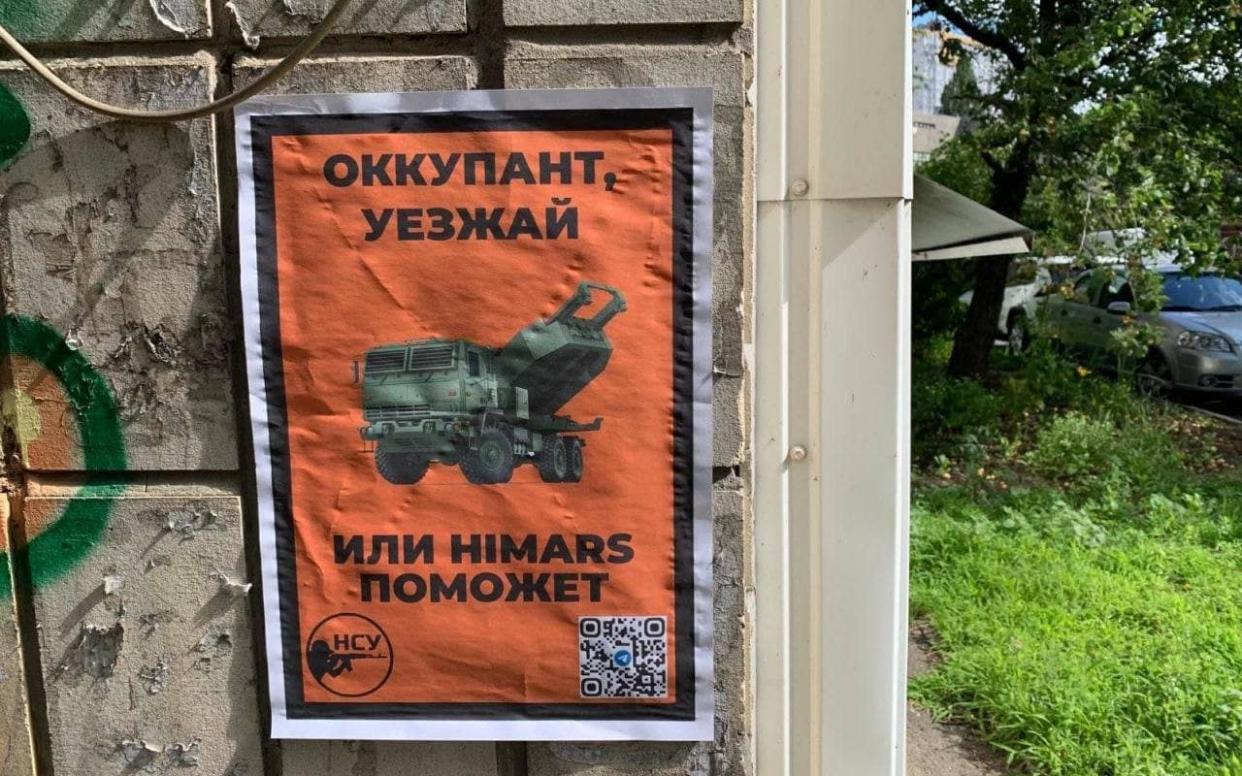Kherson’s partisans tell the Russians: ‘Can’t leave? Himars will help you’

Civilians have begun to leave Kherson amid fears of a major urban battle between the occupying Russian garrison and an approaching Ukrainian counter-offensive.
The exodus came as posters of the US-supplied Himars weapons system appeared on the city’s streets, urging Russian soldiers to leave.
“No one in Kherson feels safe,” said Alexander Smurikov, a 22-year-old who left with his mother and younger sisters on Wednesday.
“There was a base 500 metres from my home. [Russian soldiers] would walk around, smoke our cigarettes and spit. The Russians march like it is their land, but I bet it will not be much longer. Ukraine is coming back.
“I am exhausted and scared for my Dad, he stayed behind at our home. There is no connection with him and my grandparents. It is dangerous to drive through Ukraine, but we had to leave before the fighting got closer.”
‘I can’t say that the city lives’
Liza, a 26-year-old who remains in the city, said “no one is happy” with the occupation and that locals were struggling with severe shortages of cash and mobile phone cover.
“I can’t say that the city lives. Most survive. There are several problems in the city now.
“Firstly, this is cashing out the hryvnia. Banks have practically stopped working.”
“And in the end, these are loud explosions, especially at night. There are many elderly people and children in the city. They are the most afraid,” she said.
Nonetheless, she insisted, there was optimism at the approach of the Ukrainian army.
“I am truly glad Ukrainian soldiers are close. It is very scary that there could be damage and victims. But I would very much like to see our wonderful soldiers in our hometown as soon as possible,” she said.
“Our people have been putting up huge resistance since the first days of the military invasion. Of course, now there is no way to go to rallies, but we continue to fight every day.”
Ukraine began urging civilians to leave Kherson earlier this month, warning of a “huge battle” to retake the city.
Yuri Sobolevsky, a deputy chairman of Kherson regional council, has urged those who can’t leave to prepare a place to shelter and stockpile water and food in readiness for the assault.
The city has seen a string of flyers and anti-occupation posters appear on walls since it was captured in March.
The latest to appear, written in Russian and showing a picture of a rocket launcher, read: “Occupier, leave now – or this Himars will help you.”
A second read: “The Himars can’t help? Then the partisans will.”
Serhiy Khlan, a lawmaker from Kherson currently in exile, said the “resistance movement” was behind the bombing of a police car in the city on Wednesday. Another official said the attack killed one policeman.
It came a month after another car bomb killed Dmytro Savluchenko, a pro-Russian youth activist who the Russians had made head of the local agency for families, youth and sports. He was the first fatality of a series of bombings targeting collaborators that began in May.
For weeks, Ukraine has been preparing a counter-offensive to retake Kherson, where Russia maintains its only bridgehead on the west bank of the Dnipro.
On Wednesday, it fired missiles at the Antonovsky road bridge across the river, which the Russian garrison on the west bank relies on for essential supplies.
Mr Khlan said on Thursday that the attack had left the road bridge entirely unusable.
The Russians had ceased using a nearby rail bridge after recent Himars strikes on ammunition dumps at railheads, he said.
The last remaining Russian-controlled bridge is the road across a hydroelectric dam at Nova Khakova, 30 miles upstream.
Kirill Stremousov, the deputy head of the Russian-installed administration in Kherson, said on Thursday that a ferry was already operating at the site of the Antonovsky bridge.
Videos on Telegram showed a make-shift structure consisting of amphibious military vehicles towing sections of pontoon bridge.
Witnesses said it was operating under the bridge superstructure to avoid artillery strikes and was carrying both civilian and military cargoes.

